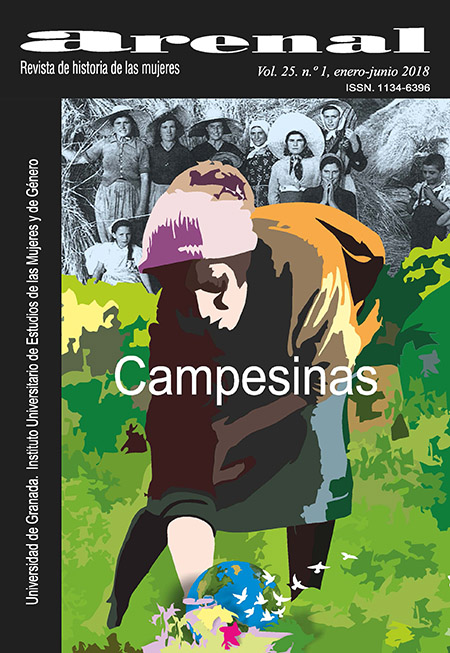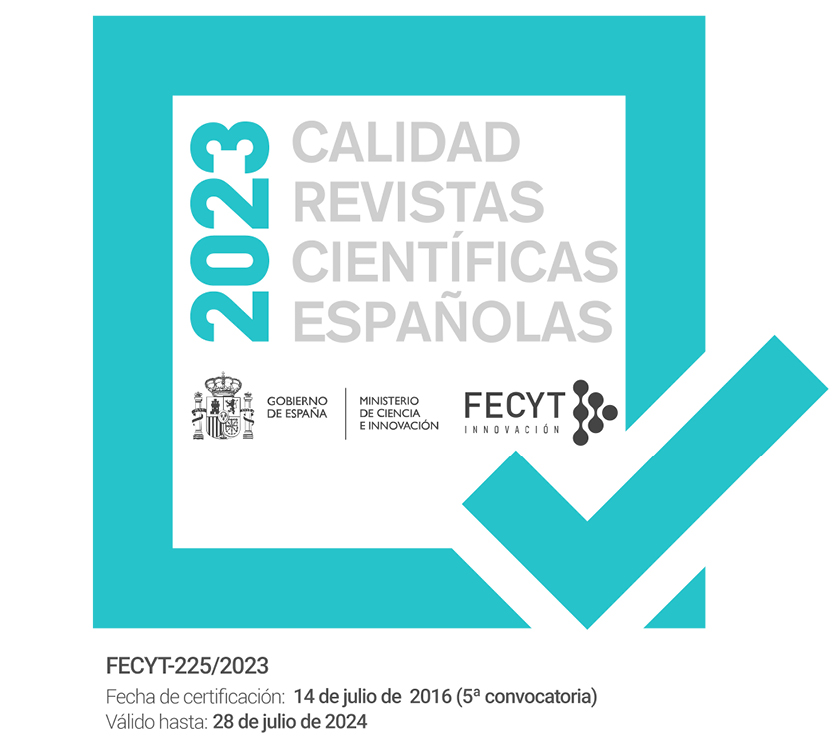The religious sphere of Roman women: public vs private space
DOI:
https://doi.org/10.30827/arenal.v25i1.5186Keywords:
Devotions, Public ceremonies, Private cults, MaterfamiliasAbstract
These pages give an overview of how the public and private space influenced the forms of religiosity of Roman women. Although the differences are not as clear as we would like, we must not forget that a devotee should be able to do everything necessary to achieve official and domestic religious stability. The literary, epigraphic and especially archaeological sources of Pompeii bring us closer to the ritual practices where the feminine presence appears symbolized iconographically. Also, their religious activities in the public sphere were reserved to matronal organizations that played a decisive role in certain festivities of the Roman calendar.Downloads
References
ALLISON, Penelope: “Using the Material and Written Sources: Turn of the Millennium Approachesto Roman Domestic Space”. American Journal of Archaeology, vol. 105, n.º 2 (2001) 181-208.
BEARD, Mary: Pompeya. Historia y leyenda de una ciudad romana. Barcelona, Crítica, 2009.
BEARD, Mary y NORTH, John (eds.): Pagan priests: religion and power in the ancient world. Londres, Duckworth, 1990.
BEARD, Mary; NORTH, John y PRICE, Simon: Religions of Rome. Cambridge, Cambridge University Press, 2006.
BOËLS-JANSSEN, Nicole: La vie religieuse des matrones dans la Rome archaïque. Roma, École Française de Rome, 1993.
BREMMER, Jan: “Myth and Ritual in Ancient Rome: The Nonae Caprotinae”. En BREMMER, Jan y HORSFALL, Nicholas (eds.): Roman Myth and Mythography. Londres, Institute of Classical Studies, 1987, pp. 76-88.
BROUWER, Hendrik: Bona Dea. The sources and a description of the cult. Leiden, E. J. Brill, 1989. CAÑIZAR, José Luis: “Domina y Vilica: espacio vital femenino en el De Agricultura Catoniano”. Habis, 43 (2012) 83-99.
CENERINI, Francesca: La donna romana: modelli e realtà. Bolonia, Il Mulino, 2009.
CHANIOTIS, Angelo: “Rituals between Norms and Emotions: Rituals as Shared Experience and Memory”. En STAVRIANOPOULOU, Eftychia (ed.): Ritual and Communication in the Graeco-Roman World. Liege, Lieu d’édition, 2006, pp. 211-238.
CHANIOTIS, Angelo y DUCREY, Pierre: Unveiling Emotions II. Emotions in Greece and Rome: Texts, Images, Material Culture. Stuttgart, Steiner Verlag, 2014.
CHARLES-LAFORGE, Marie-Odile: “Le Culte impérial à Pompéi: demeures privées et autels compitaux”. En CABOURET, Bernadette y CHARLES-LAFORGE, Marie-Odile: La norme religieuse dans l’Antiquité. París, De Boccard, 2011, pp. 125-173.
CID, Rosa M.ª: “El ordo matronarum y los espacios femeninos en la Roma antigua. Las fiestas de matronalia y fortuna muliebris”. En NASH, Mary et alii (eds.): Pautas históricas de sociabilidad femenina: rituales y modelos de representación. Actas del V Coloquio Internacional de la Asociación Española de Investigación Histórica de las Mujeres (A.E.I.H.M.): Cádiz, 5, 6 y 7 de junio de 1997. Cádiz, Universidad de Cádiz, 1999, pp. 43-57.
CID, Rosa M.ª: “Imágenes y prácticas religiosas de la sumisión femenina en la antigua Roma. El culto de Juno Lucina y la fiesta de matronalia”. Stud. hist., H.ª Antig., 25 (2007) 357-372.
CLARKE, John: The houses of roman Italy, 100 BC-AD 250. Ritual, space and decoration. Berkeley, University of California Press, 1991.
CLARKE, John: Art in the lives of ordinary Romans. Visual representation and non-elite viewers in Italy, 100 B.C.-A.D. 315. Berkeley, University of California Press, 2003.
DOLANSKY, Fanny: “Honouring the family dead on the Parentalia: ceremony, spectacle, and memory”. Phoenix, vol. 65 (2011a) 125-157.
DOLANSKY, Fanny: “Celebrating the Saturnalia: Religious Ritual and Roman Domestic Life”. En RAWSON, Beryl (ed.): A Companion to Families in the Greek and Roman Worlds. Oxford, Wiley-Blackwell, 2011b, pp. 488-503.
DOLANSKY, Fanny: “Reconsidering the Matronalia and women’s rites”. Classical World, 104.2 (2011c) 191-209.
DYSON, Steve: “The Family and the Roman Countryside”. En RAWSON, Beryl (ed.): A Companion to Families in the Greek and Roman Worlds. Oxford, Wiley-Blackwell, 2011, pp. 431-444.
EDLUND-BERRY, Ingrid: “Whether Goddess, Priestess, or Worshipper: Considerations of Female Deities and Cults in Roman Religion”. Festschrift in Honor of Gösta Säflund, Opus Mixtum. Acta Instituti Romani Regni Sueciae, vol. 21 (1994) 25-33. EGELHAAF-GAISER, Ulrike: “Roman Cult Sites: A Pragmatic Approach”. En RÜPKE, Jörg (ed.): A Companion to Roman Religion. Oxford, Blackwell Publishing, 2007, pp. 205-222.
FISHWICK, Duncan: Cult, Ritual, Divinity and Belief in the Roman World. Farnham/Burlington, Ashgate/Variorum, 2012.
FOSS, Pedar: “Watchful Lares: Roman Household organization and the rituals of cooking and eating”. En LAURENCE, Ray y WALLACE-HADRILL, Andrew (eds.): Domestic Space in the Roman World: Pompeii and beyond, Journal of Roman Archaeology, suppl. 22, Portsmouth, RI, 1997, pp. 197-218.
FRÖHLICH, Thomas: Lararien und Fassadenbilder in de Vesuvstädten. Untersuchungen zur “volkstümlichen” pompejanischen Malerei. Mainz Am Rhein, Von Zabern, 1991.
GAGÉ, Jean: Matronalia: essai sur les dévotions et les organisations cultuelles des femmes dans l’ancienne Rome. Bruselas, Coll. Latomus, 1963.
GALESTIN, Marjan: “Dating of roman statuettes: fixed types and changing styles”. En Acta of the 12th International Congress on Ancient Bronzes. Nijmegen, 1995, pp. 253-260.
GARDNER, Jean y WIEDEMANN, Thomas: The Roman House-hold: A Sourcebook. Londres/Nueva York, Routledge, 1991.
GIACOBELLO, Federica: Larari pompeiani. Iconografia e culto dei Lari in ambito domestico. Milán, LED, 2008.
GLADIGOW, Burkhard: “Sequenzierung von Riten und die Ordnung der Rituale”. En STAUSBERG, Michael (ed.): Zoroastrian Rituals in Context. Leiden/Boston, 2004, pp. 57-76.
GRIFFITH, Alison: “Reconstructing Religious Ritual in Italy”. En DE ROSE, Jane (ed.): A Companion to the Archaeology of the Roman Republican Period. Oxford, Clarendon Press, 2013, pp. 235-250.
HARMON, Daniel: “The Family Festivals of Rome”. ANRW II, 16.2 (1978) 1592-1603.
HEMELRIJK, Emily: “Women and sacrifice in the Roman Empire”. En HEKSTER, Olivier et alii (eds.): Ritual Dynamics and Religious Change in the Roman Empire: Proceedings of the Eighth Workshop of the International Network Impact of Empire. Leiden/Boston, Brill, 2009, pp. 253-267.
KRZYSZOWSKA, Anna: Les cultes privés à Pompéi. Wroclaw, Wydawn, 2002.
LIPKA, Michael: Roman Gods: A Conceptual Approach. Religions of the Graeco-Roman World. Leiden/Boston, Brill, 2009.
MAIURI, Arduino: Sacra privata. Rituali domestici e istituti giuridici in Roma antica. Roma, L’Erma di Bretschneider, 2013.
MASTROCINQUE, Attilio: “Dionysos and Religious Experiences in Bona Dea Rituals”. En CUSUMANO, Nicola et alii (eds.): Memory and Religious Experience in the Greco-Roman World. Stuttgart, Franz Steiner Verlag, 2013, pp. 167-176.
Nicola et alii (eds.): Bona Dea and the cults of Roman women. Stuttgart, Franz Steiner Verlag, 2014.
MATHIEU, Nicolas y RÉMY, Bernard: Les femmes en Gaule romaine. París, Errance, 2009.
MIRÓN, M.ª Dolores: Mujeres, religión y poder: el culto imperial en el Occidente Mediterráneo. Granada, Universidad de Granada, 1996.
MOLINA, M.ª Pilar: “La matrona ideal según las fuentes literarias grecorromanas de finales de la República al S. I d.C.”. Espacio, tiempo y forma. Serie II, Historia Antigua, vol. 29 (2016) 57-70.
ORIA, Mercedes: “Sacerdotisas y devotas en la Hispania antigua: un acercamiento iconográfico”. SPAL, 21 (2012) 75-88.
ORIA, Mercedes: “De mujeres y sacrificios: un estudio de visibilidad”. Saldvie, 10 (2010) 127-147.
PARKER, Robert: “Public and private”. En RAJA, Rubina y RÜPKE, Jörg (eds.): A Companion to the Archaeology of Religion in the Ancient World. Oxford, Wiley Blackwell, 2015, pp. 71-81
PÉREZ, María: Al amparo de los Lares. El culto doméstico en las provincias romanas Bética y Tarraconense. Anejos de Archivo Español de Arqueología, 68. Madrid, 2014.
ROSENBERGER, Veit: “Öffentlich/privat bei den Römern”. ThesCRA, 8 (2012) 11-16.
ROTONDI, Valentina: Il sacrificio a Roma. Riti, gesti, interpretazioni. Roma, Aracne, 2013.
RUBIERA, Carla: “Vilicus et vilica. Estereotipos masculinos y femeninos de la población esclava en la literatura de los agrónomos greco-latinos”. Arenal, 17.2 (2010) 351-377.
SCHEID, John: “ ‘Extranjeras’ indispensables. Las funciones religiosas de las mujeres en Roma”. En DUBY, George y PERROT, Michelle (eds.): Historia de las mujeres en Occidente. La Antigüedad. Madrid, Taurus, vol. I, 1991, pp. 421-462.
SCHEID, John: “Les roles religieux des femmes à Rome. Un complément”. En FREISTOLBA, Regula et alii (eds.): Les femmes antiques entre sphère privée et sphère publique. Berne, P. Lang, 2003, pp. 137-151.
SCHEID, John: “Quand faire c’est croire. Les rites sacrificiels des Romains”. L’Homme, 182 (2005) 295-299.
SCHULTZ, Celia: Women’s religious activity in the Roman Republic. Chapel Hill, University of North Carolina Press, 2006.
SIRAGO, Vito Antonio: Femminismo a Roma nel Primo Imperio. Catanzaro, Rubbettino Editore, 1983.
SMITH, Christopher: “Worshipping Mater Matuta: Ritual and Context”. En BISPHAM, Edward y SMITH, Christopher (eds.): Religion in Archaic and Republican Rome and Italy: Evidence and Experience. Edimburgo, Universidad de Edimburgo, 2000, pp. 136-155.
TURCAN, Robert: The Gods of Ancient Rome: religion in everyday life from archaic to imperial times. Nueva York, Routledge, 2000.
VAN ANDRINGA, William: “Dal sacrificio al banchetto: rituali e topografia della casa romana”. En BASSANI, Maddalena y GHEDINI, Francesca (eds.): Religionem Significare. Aspetti storico-religiosi, strutturali, iconografici e materiali dei sacra privata. Atti dell’incontro di studi (Padova, 8-9 giugno 2009). Roma, Edizioni Quasar, 2011, pp. 91-98.
Downloads
Additional Files
Published
How to Cite
Issue
Section
License
Los/as autores/as que publican en esta revista están de acuerdo con los siguientes términos:
Los autores/as conservarán sus derechos de autor y garantizarán a la revista el derecho de primera publicación de su obra, el cuál estará simultáneamente sujeto a la Licencia de reconocimiento de Creative Commons 4.0 BY-NC-ND que permite a terceros compartir la obra siempre que se indique su autor y su primera publicación esta revista.
Los autores/as podrán adoptar otros acuerdos de licencia no exclusiva de distribución de la versión de la obra publicada (p. ej.: depositarla en un archivo telemático institucional o publicarla en un volumen monográfico) siempre que se indique la publicación inicial en esta revista.
Se permite y recomienda a los autores/as difundir su obra a través de Internet (p. ej.: en archivos telemáticos institucionales o en su página web) antes y durante el proceso de envío, lo cual puede producir intercambios interesantes y aumentar las citas de la obra publicada. (Véase El efecto del acceso abierto).


















